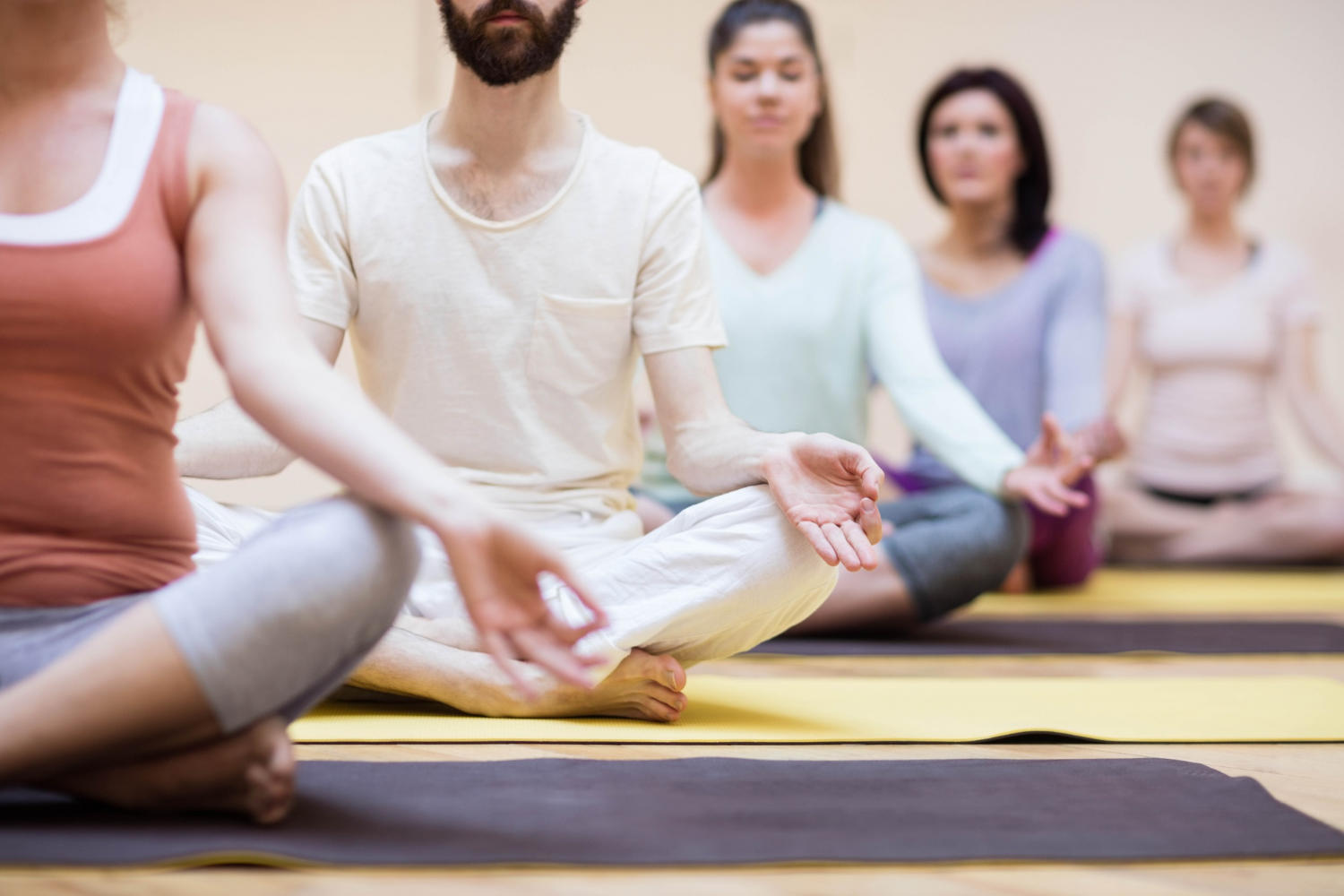Yoga is an age-old practice that has evolved over the centuries. The original purpose of yoga dates back thousands of years in ancient India. Initially, yoga was developed as a spiritual practice aimed at achieving harmony between the mind, body, and spirit.
Its primary goal was to facilitate meditation and self-realization. The practice involved physical postures (asanas), breathing exercises (pranayama), and meditation to promote physical health, mental clarity, and spiritual growth. Over time, various forms and styles of yoga emerged, each emphasizing different aspects such as physical fitness, mental discipline, or spiritual enlightenment. Despite its evolution, the fundamental aim of yoga remains rooted in achieving inner balance and self-awareness.
Today, when we talk about yoga, we think of a kind of gentle gymnastics, in which you move your body in a string of easy and more difficult movements.
But did you know that this has not always been the case?
Going back to the origin of yoga together, we will find that there are several types of yoga, not always practiced in the same way...

Where Does Yoga Come From?
Yoga was invented in ancient India, around 5,000 years ago.
The word "yoga" comes from the Sanskrit language, and means "to unite" or "to join". Yoga was originally developed as a spiritual practice, with the goal of achieving enlightenment and inner peace through physical and mental exercises.
The earliest written records of yoga date back to the Vedas, a collection of ancient Hindu scriptures. Over time, yoga evolved into a more structured practice, with a focus on physical postures, breathing techniques, and meditation. The most famous text on yoga is the Yoga Sutras, written by the sage Patanjali in the second century BCE.
Today, yoga has become a popular form of exercise and relaxation around the world, with many different styles and variations. While its spiritual roots are still respected by many practitioners, yoga is now often practiced primarily for its physical and mental health benefits.
What does Asana mean?
Asana is a Sanskrit word that refers to the physical postures or poses practiced in yoga. The word "Asana" comes from the root word "As," which means "to sit" or "to be present."
In yoga, the practice of Asanas is designed to help prepare the body for meditation and to promote physical health and wellbeing. There are many different types of Asanas, each with its own unique benefits and challenges. Some Asanas are designed to strengthen and tone the muscles, while others focus on increasing flexibility and improving balance.
The practice of Asanas is an important part of traditional Hatha yoga, which is the branch of yoga that focuses on physical postures and breath control. Today, Asanas are also practiced in many other styles of yoga, including Vinyasa, Ashtanga, and Iyengar yoga.
What Are The 8 Elements of Yoga?
The eight elements of yoga, also known as the "Ashtanga Yoga," are a set of fundamental principles and practices that form the foundation of classical yoga. These elements were systematized by the ancient sage Patanjali in his seminal work, the Yoga Sutras. Here's a comprehensive explanation of each element:
- Yama (Restraints):
- Ahimsa (Non-violence): Practicing compassion and kindness towards all living beings.
- Satya (Truthfulness): Being honest and authentic in thoughts, words, and actions.
- Asteya (Non-stealing): Refraining from taking what is not rightfully yours.
- Brahmacharya (Moderation): Cultivating self-discipline and moderation in all aspects of life.
- Aparigraha (Non-possessiveness): Letting go of attachment to material possessions and desires.
- Niyama (Observances):
- Saucha (Purity): Maintaining physical, mental, and emotional cleanliness.
- Santosha (Contentment): Cultivating a sense of gratitude and contentment with what you have.
- Tapas (Self-discipline): Practicing austerity, self-control, and perseverance.
- Svadhyaya (Self-study): Engaging in self-reflection, introspection, and the study of sacred texts.
- Ishvara Pranidhana (Surrender): Dedicating one's actions and life to a higher power or divine source.
- Asana (Physical Postures):
- Practicing various physical postures to strengthen and align the body, improve flexibility, and promote overall well-being.
- Pranayama (Breath Control):
- Techniques to control and regulate the breath helps calm the mind, increase energy levels, and improve overall health.
- Pratyahara (Sense Withdrawal):
- Turning the senses inward to disconnect from external distractions and focus on the inner world.
- Dharana (Concentration):
- Developing the ability to focus and concentrate the mind on a single point or object.
- Dhyana (Meditation):
- The practice of deep meditation, where the mind becomes absorbed in the object of concentration.
- Samadhi (Union):
- The ultimate goal of yoga, is where the individual experiences a state of complete union with the divine or the true self.
These eight elements provide a holistic approach to yoga, encompassing physical, mental, and spiritual aspects. By integrating these principles and practices into one's life, one can achieve a harmonious balance and experience the transformative power of yoga.
What Does Pranayama Mean?
Pranayama is a Sanskrit word that refers to the practice of breath control in yoga.
The word "pranayama" comes from the root words "prana," which means "life force" or "vital energy," and "yama," which means "control" or "restraint."
In yoga, pranayama involves a variety of breathing techniques and exercises that are designed to enhance the flow of prana, or life force, throughout the body. By controlling the breath, practitioners of pranayama aim to balance and regulate the body's energy, reduce stress and anxiety, and promote overall health and wellbeing.
There are many different types of pranayama exercises, ranging from simple deep breathing techniques to more complex practices that involve holding the breath or controlling the flow of air through the nostrils. Some common pranayama exercises include Ujjayi breath, Nadi Shodhana (alternate nostril breathing), and Kapalabhati (skull-shining breath).
Pranayama is often practiced in conjunction with other yoga practices, such as asanas (physical postures) and meditation. Together, these practices help to promote physical and mental health, and to cultivate a deeper sense of awareness and connection to the self and the world around us.
The Origins of Yoga
Historians and specialists in Indian culture find it very difficult to precisely locate the origins of yoga.

The reason why the origins of yoga are not clear… ancestral texts are extremely difficult to decipher!
Even when it is actually possible to find writings, it’s still difficult. This is because, according to experts, the Vedic culture (at the origin of everything) were supporters of oral transmission.
That said, research indicates that the first forms of yoga would have emerged between 10,000 and 5,000 BC. J.-C. Figurines found on ancient sites resembled the position of yogis meditating.
The purpose of yoga at that time was to be able to impose power on the gods by doing regular exercises that were very hard for the body.
Over time, this discipline has evolved. This is largely due to a writer (who could in fact be a line of writers): Patañjali and his Yoga Sutra, directly responsible for the great history of yoga!
Composed of 195 aphoras (short sutras or phrases that are easily memorised) and 1161 words in all, divided into 4 paragraphs. Each part aims to define what yoga is and how to practise it to attain liberation (the ultimate goal of the discipline).
- The first section is called Samadhi pada (chapter on concentration).
The author explains how to attain the state of unity by samadhi (completion or ecstasy in Sanskrit).
- The second section is called Sadhana pada (chapter on the practice).
There are two forms of yoga: Ashtanga Yoga (based on 8 members instituting a healthy and beneficial philosophy of life for oneself and others) and Kriya Yoga (the yoga of action).
- The third section is called Vibhuti pada (chapter on the powers).
It refers precisely to the techniques that lead to a higher state of consciousness.
- The fourth and final section is Kaivalya pada (chapter on liberation).
She closes the text by returning to the ultimate goal of yoga.
Previously, the yogis spoke of isolation and loneliness. Today we talk about the liberation and harmony of our being with our surrounding environment.
It is this text that governs all contemporary strands of yoga, as described in the Yoga Sutra. Either:
- The four traditional approaches are Karma Yoga, Bhakti Yoga, Jnana Yoga (these three disciplines form the trimarga or the path to awakening) and Raja Yoga.
- The methods of Kriya Yoga: Tantra Yoga, Mantra Yoga and Hatha Yoga.
Each has its own practices and exercises.
Check for yoga classes near me here.

What Role Does Mantras Play In Yoga?
Mantras play an important role in yoga, particularly in the practice of meditation and chanting. A mantra is a sacred sound or word that is repeated over and over again during meditation or chanting. The word "mantra" comes from the Sanskrit language and means "instrument of the mind."
In yoga, mantras are used to help focus and quiet the mind and to promote a sense of inner peace and spiritual connection. Mantras are often associated with specific deities or spiritual concepts, and are believed to have a powerful and transformative effect on the mind and body.
Chanting mantras is a common practice in many forms of yoga, including Kundalini, Hatha, and Bhakti yoga. Chanting can be done individually or in a group, and is often accompanied by music or instruments. The repetitive nature of chanting mantras helps to create a meditative state of mind and can lead to a deeper sense of inner peace and connection to the divine.
In addition to meditation and chanting, mantras can also be used as a form of affirmation or positive self-talk. By repeating a positive affirmation or mantra, you can help to reprogram your subconscious mind and cultivate a more positive and empowering mindset.
Learn effective and moving mantras in yoga classes.
Past And Present: How Is Yoga Practiced In the World?
After dwelling on the origins, let's learn about the evolution of yoga through the ages!
Let’s return then to its beginnings, some millennia before the year 0. We are now in the Antiquity.
The first texts that mention the practice of a form of meditation including precise poses and the recital of a kind of incantation come from the Vedic civilisation. This is what gave rise to Brahmanism, a formalized ritual system of this ancient culture.
This appears towards the 10th century BC. AD.
Find private teachers for online yoga classes here.

Around the 4th century BC, the Yoga Sutra was written.
Thus, following these rules, different orders of yogis emerged (including Vishnouite and Shivaite yogis), hence linking this practice to religious forms of Hindu culture (but not totally).
From the 2nd century AD. J.-C. the practice spread across the world. This is primarily due to the Arabs, Greeks, and Persians. But also due to a famous Italian explorer: Marco Polo.
Precise translations and descriptions of these Hindu rites are then published in the West.
Subsequently, towards the 16th century, everything starts to accelerate. The different cultural and commercial exchanges between peoples encouraged the discovery of new practices, including yoga.
As a result, various Western texts cite yoga between the 16th and the 18th century.
As the 19th century arrived and technologies advanced, it became increasingly easy to travel and communicate. Thus, great yogis took advantage of it to explain to the whole world the true nature of yoga.
Among the important names, we think of:
- Swami Vivekananda (1863-1902): he held numerous lectures on yoga;
- Sri Krishnamacharia (1888-1989): he founded a yoga school in India;
- K.V. Desikachar (son of Sri Krishnamacharia): he strove to make the practice known throughout the world;
- Bellur Krishnamachar Sundararaja Iyengar (1918-2014): founder of Yoga Iyengar;
- Sri Krishna Pattabhi Jois (1915-2009): teacher of Yoga Ashtanga.
Check for yoga classes in Goa on Superprof.

In the late 19th century, yoga masters began to travel to the West, sparking interest and new followers.
During this period, a large number of federations and associations were created throughout the world.
Among these new followers was, of course, Britain. During the mid-twentieth century the art form became popularised, appealing to the British people due to its emphasis on both physical and spiritual wellbeing.
By the end of the twentieth century it had become a mainstream activity and a huge commercialised business.
In Britain, the discipline is essentially known in its Hatha Yoga form. But there are many others. Learn about all this philosophy at a yoga class in London or across the country...
Different Forms of Yoga
Let us turn to the traditional and modern forms of yoga.
You will find that there are many types, each with its own objectives, practices and exercises.
Hatha Yoga
In the West, Hatha Yoga is undoubtedly the most widespread form of this discipline.
It consists of linking and maintaining poses, while promoting breathing and concentration. Not to mention relaxation, which is an important part of the exercise.
Its goal is to work your flexibility, but also to have better stress management or improve the quality of your sleep.
It's a pretty comprehensive variety.

Kundalini Yoga
Kundalini Yoga allows you to harmonise your energy centres.
To achieve this, it focuses on practising yoga poses accompanied by breathing exercises, meditation and relaxation.
The idea is to offer you a better physical and mental balance while strengthening your immune system and letting go of daily stress.
Iyengar Yoga
The Yoga Iyengar (named after its inventor: BKS Iyengar) was created a short time ago.
Its principle is to offer a gentle approach to the exercise by allowing you to help yourself with equipment.
Designed primarily for beginners, it also brings many physical and spiritual benefits.
Prenatal Yoga
As the name suggests, prenatal yoga is for pregnant women who want the right aids to deal with their pregnancy and childbirth.
Thus, yoga postures are adapted to the changing body. Each yoga session offers different exercises that will help you to:
- Relax and avoid mood swings;
- Maintain your flexibility (or gradually improve it);
- Be in touch with your child and your changing body;
- Be calm on the delivery day through inspirational/expiratory exercises that will help you on D day;
- Not to mention avoiding the bodily pains that you experience during this period.

Be careful though: this yoga class requires the help of a professional. It is not advisable to practice it at home, if you are not already an expert.
If you’re looking to begin safely under expert guidance, you can explore yoga classes Bangalore to find experienced instructors near you.
Yoga Nidra
Yoga Nidra is a rather unusual practice of yoga since you do not string together movements.
In fact, you lie down and you enter a state close to sleep (the same as sophrology).
By taking a slow, deep breath, you relax and put aside all negative feelings.
If you have problems sleeping or if you have trouble managing your emotions, this is the type of Yoga for you!
Raja Yoga
Raja Yoga is also called Ashtanga Yoga. It is based on 8 members who are spiritual precepts to achieve the desired state of unity.
Considered the most comprehensive form, it draws from all types of yoga!
Vinyasa Yoga
Let's finish our selection with Vinyasa Yoga, which draws heavily on Astanga Yoga.
Yet, while the second consists of always performing the same series of movements, Vinyasa Yoga is much freer.
Very energetic, you follow your yogi master who links poses one after the other, in a fluid and rhythmic way.
Therefore, you need to be a decent athlete to be able to have a go at it.
In any case, it allows you to sculpt your body without building it up (unlike bodybuilding) while eliminating any superfluous fat that has accumulated.
Obviously, there are many others that we invite you to discover at your own pace.
You can learn about all kinds of yoga or focus on a specific one with yoga classes on Superprof.
Most Prominent Yogis in The History Of Yoga
Yoga has a rich and diverse history, and there have been many prominent yogis and yoga teachers who have made significant contributions to the development and popularization of the practice. Here are a few of the most prominent yogis in the history of yoga:
- Patanjali: Patanjali is often referred to as the father of modern yoga. He is credited with writing the Yoga Sutras, a foundational text of yoga that outlines the eight limbs of yoga and provides guidance on the practice of yoga as a path to spiritual enlightenment.
- Swami Vivekananda: Swami Vivekananda was a 19th-century Indian monk who played a key role in introducing yoga and Vedanta to the Western world. He traveled extensively throughout the United States and Europe, giving lectures on yoga and Indian philosophy.
- T. Krishnamacharya: T. Krishnamacharya is considered one of the most influential yoga teachers of the 20th century. He developed the vinyasa style of yoga, which emphasizes the flow of breath and movement, and he taught many of the most prominent yoga teachers of the modern era, including B.K.S. Iyengar and Pattabhi Jois.
- B.K.S. Iyengar: B.K.S. Iyengar is known for developing the Iyengar style of yoga, which emphasizes precise alignment and the use of props to help students achieve correct alignment in postures. He also authored several influential books on yoga, including "Light on Yoga."
- Pattabhi Jois: Pattabhi Jois is known for developing the Ashtanga style of yoga, which is a vigorous and dynamic practice that emphasizes a set sequence of postures and synchronized breath. His teachings have influenced many modern styles of yoga, including Power Yoga and Vinyasa Flow.
What do I do if there are no classes for yoga near me? There are also individual teachers or groups you can join.
In any case, if you feel overwhelmed by stress and if it affects your body, give yourself a break in life. You will soon see the benefits.
























